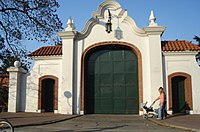Olivos, Buenos Aires
Olivos | |
|---|---|
 | |
| Country | |
| Province | |
| Partido | Vicente López |
| Founded | 1870 |
| Government | |
| • Mayor | Jorge Macri |
| Elevation | 18 m (59 ft) |
| Population | |
| • Total | 75,527 |
| • Density | 9,808.7/km2 (25,404/sq mi) |
| CPA Base | B 1636 |
| Area code | +54 11 |
Olivos is an Argentine city in Vicente López Partido in the Province of Buenos Aires and a suburb within the Greater Buenos Aires metro area.
Olivos is the site of the official residence of the President of Argentina (the name of this compound is the Quinta Presidencial de Olivos) and a relatively exclusive residential area where most heads of households commute to Buenos Aires, 22 km (14 mi) to the south. The city is bordered on the east by the shores of the Río de la Plata.
History



A well-known stop along the Buenos Aires-Córdoba trade route for much of the 18th century, one of the area's first landowners, Domingo de Acassuso, began cultivating olive trees around 1720 and the spot was officially named Olivos on 19 February 1770. Much of the area was later purchased by Viceroy Antonio de Olaguer y Feliú and by a German immigrant, Hernán Wineberg, who sold a large tract in 1860 for the construction of the Ferrocarril Central Argentino through the area. The 1863 inaugural of the local railway station, one of Argentina's first, began attracting homeowners drawn by the area's tranquility and convenient access to the rapidly growing capital and, in 1897, the Church of Jesus of the Olive Trees was consecrated. A 1905 edict subdivided San Isidro Partido in two, creating the modern Partido de Vicente López and designating Olivos as the seat.
Home to a growing upscale community by 1917, local businessman Rodolfo Negrete founded the city's first clinic and marina and, during the 1920s, the small marina was modernized and the city's streets paved. The opening of National Route 9 in the mid-1930s, west of the city, further accentuated the area's draw as a convenient suburb for Buenos Aires commuters. The city became the focus of national attention in 1941 when, upon the passing of Carlos Villate Olaguer (a great-great-grandson of Viceroy Olaguer y Feliú's), a 35 hectares (86 acres) section of the family's local land was deeded to the national government for use as the president's official residence. Graced by a mansion of an eclectic, Neo-Gothic-inspired style, the main house was commissioned by Miguel José de Azcuénaga in 1851 and designed by renowned local artist and architect Prilidiano Pueyrredón. The complementing structures for the compound were built in variations on Baroque architecture.
The residence hosted the Olivos Pact, a political agreement signed on 14 November 1993 between then-President Carlos Menem and former President Raúl Alfonsín (head of the main opposition party, the centrist Radical Civic Union). The pact secured support for constitutional reforms allowing for the re-election of the President well as for the popular election of the Mayor of Buenos Aires, hitherto an appointed post. The city was also witness to the Kheyvis nightclub fire (20 December 1993), the deadliest such tragedy in Argentina up to that point. Olivos was selected as a stop along the Tren de la Costa tourist railway upon the line's opening in 1994.
External links
- Municipal information: Municipal Affairs Federal Institute (IFAM), Municipal Affairs Secretariat, Ministry of Interior, Argentina. (in Spanish)
- Template:Es icon Municipal website
